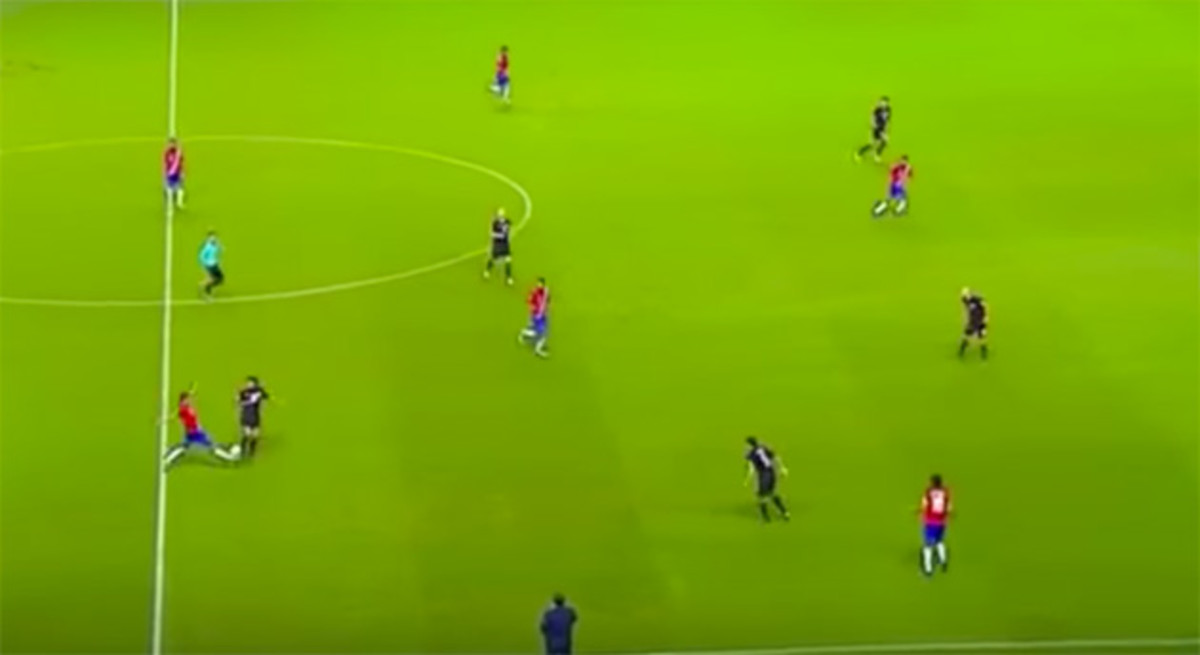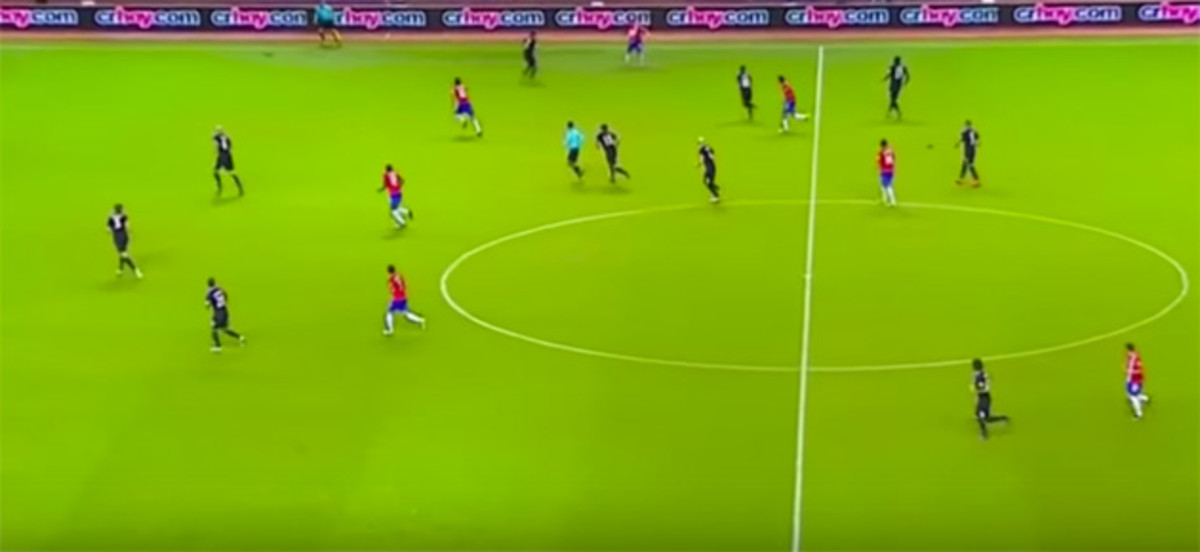Digging deeper into USA's catastrophic defending, Brooks's shocker vs. Costa Rica

With every towering header, every authoritative tackle, every triumphant physical duel and every breathtaking recovery run at this past summer’s Copa America Centenario, John Brooks’s stock was skyrocketing.
Brooks helped anchor a U.S. back four that conceded just one goal from open play prior to the semifinals. He was one of the best players at the tournament, regardless of team or position. He was physically imposing. He was combative. He was convincing.
He was everything that he wasn’t Tuesday night in San Jose, Costa Rica.
Brooks had a nightmarish 90 minutes as the U.S. slumped to arguably the worst defeat of the Jurgen Klinsmann era.
USA's dire start to the Hex shows it's time for Jurgen Klinsmann to go
Perhaps it was because Brooks’s center back partner, Geoff Cameron, missed out with an injury. Perhaps it was the unfamiliar environment. Perhaps it was Klinsmann’s comments four nights earlier (more on that later). Perhaps it was entirely fluky. Whatever the explanation, Brooks played his worst game in a national team jersey at the worst of times, and each goal provided damning evidence that something was up. Here's a closer look at the USA's defensive calamity in Costa Rica:
Early issues
Even before the goals started flying in, before the game tumbled out of control, there were ominous signs of a sluggish Brooks. A weak seventh-minute clearance incited a Ticos attack, which reached the penalty area as Brooks trailed Johan Venegas’s run. Brooks’s faulty body shape then left him susceptible to a nutmeg from Venegas, who skipped past the American defender and was denied from close range by Brad Guzan.
Seven minutes later, Brooks got back to snatch a volley off the foot of Venegas. It appeared to be a good recovery. But as the play developed, and Christian Bolaños’s lofted ball found the chest of Bryan Ruiz, Brooks more or less stood and watched—the only reason he had to scramble back at all. An up-to-speed recovery run would have put the American center back in position to clear the initial rebound—or intercept a layoff from Ruiz, had the Costa Rica playmaker spotted Venegas.
(via beIN Sports)
Brooks’s errant 43rd-minute pass then led to Costa Rica’s opener.
Costa Rica 1, USA 0
The U.S. attempted to play through, around and out of Costa Rican pressure. Jermaine Jones’s ball to Brooks was a midfielder’s equivalent of a death wish, but the Hertha Berlin center back’s handling of it was nonetheless that of a man lacking confidence. He was off balance and failed to get his feet right as the ball sped at him. His giveaway, and Jones’s loss of a 50-50 ball, essentially gave Costa Rica a 6-on-4 break.

The mismanagement of that 6-on-4 doesn’t begin with Brooks, nor with any of the defenders, however. It begins with Jones, then continues with Michael Bradley. Right when Jones loses the duel, Bradley must make a decision. Should he close down the ball? Should he cut off the pass to the Costa Rican player over his left shoulder, Celso Borges? Or the pass to the player to his right, Randall Azofeifa?
The problem is that Bradley does none of those things. He marks nobody:
(via beIN Sports)
Fabian Johnson recovers to close down Azofeifa, but Bradley’s indecision and failure to cut off the passing lane to Borges draw both Brooks and Matt Besler to Borges. In the above clip, watch Brooks hop forward as Azofeifa receives the ball.
Had Bradley slid to his left, Brooks could have dropped to mark Venegas, Costa Rica’s most advanced player, and Omar Gonzalez–covering for Timmy Chandler, who was caught way up the field on this sequence–could have slid more promptly to his right to mark Bolaños. Instead, Brooks steps, Gonzalez stays with Venegas, and the cross-field outlet is on. The weight of the ball allows Brooks to comfortably get goal side of Venegas, but he inexcusably doesn’t get tight to him, and is flat-footed as Venegas darts to the near post and beats Guzan. (Gonzalez’s lackadaisical on-ball defending doesn’t help.)
Venegas gets his noggin on a Bolaños' cross to put @FEDEFUTBOL_CR in front before the break. #beINCONCACAF https://t.co/S8dCMkkJA3
— beIN SPORTS USA (@beINSPORTSUSA) November 16, 2016
Costa Rica 2, USA 0
Further evidence that Brooks was a shell of his usual self came not in the form of a clear-cut error, but rather a choice. On the buildup to Costa Rica’s second goal, as Besler stepped from his left back spot to pressure Azofeifa, the U.S. found itself positioned as follows:

The American defenders are 3-v-2 along the back line—until, that is, Bryan Ruiz bolts into the space vacated by Besler and Azofeifa pops a ball down the line into his path.
The U.S. should now be 3-v-3, with Brooks theoretically free to slide over and put immediate pressure on the ball. Over the summer at Copa America, when he was in the form of his life, he almost assuredly would have. He would have read the play, and made Ruiz uncomfortable before he could get his head around and drive towards the end line. He likely would have won the 1-v-1 battle.
This, rather confoundingly, was not the same Brooks. It was a more hesitant Brooks, one who instead chose to drop straight back toward his team’s goal and force Jones to make a 50-yard diagonal recovery run. As Jones traverses those 50 yards, crucially, there’s no pressure on the ball. Ruiz has time to pick his head up and shape a piercing cross.
Bolaños involved again as @FEDEFUTBOL_CR double their lead. #beINCONCACAF https://t.co/95XsjOz0DU
— beIN SPORTS USA (@beINSPORTSUSA) November 16, 2016
Many will point to Brooks’s poor marking at the back end of the play. But it was his initial decision that was so uncharacteristic and ultimately ill-fated.
Goals No. 3 and 4
Four days before the disaster in San Jose, Brooks was at fault on Rafa Marquez’s winner in Columbus. Rather than allow his stalwart center back to expel the error from his mind, Klinsmann blamed Brooks for the goal in his postmatch press conference, calling him out by name. Brooks subsequently apologized to the entire team—something Klinsmann again relayed to the media.
Just like that, Brooks’s mistake was ingrained. That’s how the human brain works. Stray thoughts, such as those of past errors, can infiltrate a player’s mind and linger as distractions. The distractions snowball; mistakes trigger memories of past mistakes, and become inhibitive.
To definitively assert that Klinsmann’s pinning responsibility on Brooks led to Tuesday’s fiasco would be both an assumption and an exaggeration. But Brooks seemed drained of every last speck of confidence. Something wasn’t right. His mind wasn’t right. Professional center backs don’t do this under normal circumstances:
Joel Campbell comes off the bench to compound @ussoccer's misery. 3-0. #beINCONCACAF https://t.co/7fx9Q4epVt
— beIN SPORTS USA (@beINSPORTSUSA) November 16, 2016
And while the fourth goal is less of an egregious error, it’s as if Brooks’s soccer brain has shut down. He freezes and doesn’t even attempt to track Joel Campbell’s run:
.@ussoccer at sixes and sevens now in as Joel Campbell strikes again for the CUATROACERO. https://t.co/e65jGGmETn
— beIN SPORTS USA (@beINSPORTSUSA) November 16, 2016
Klinsmann, as a manager, has his shortcomings and his strengths. His main shortcoming is his tactics. For the most part, those weren’t the problem Tuesday. Tactics don’t inexplicably flail at falling balls. Players do.
On the other hand, one of Klinsmann’s strengths is supposedly his man management—his ability to inspire extraordinary individual efforts from those players. A part of that is understanding those individuals and what type of motivation they require to be at their best. Whatever Brooks required, he didn’t get it between Friday and Tuesday. He certainly didn’t have what he needed to play through mistakes and play with conviction amid doubt.
Brooks wasn’t the only problem Tuesday, nor was Tuesday the only problem for this U.S. men’s program. But Brooks’s puzzling collapse, and the possibility that Klinsmann’s handling of his previous mistake contributed to that collapse, are yet more unwelcome problems for a team suddenly inundated with them.
